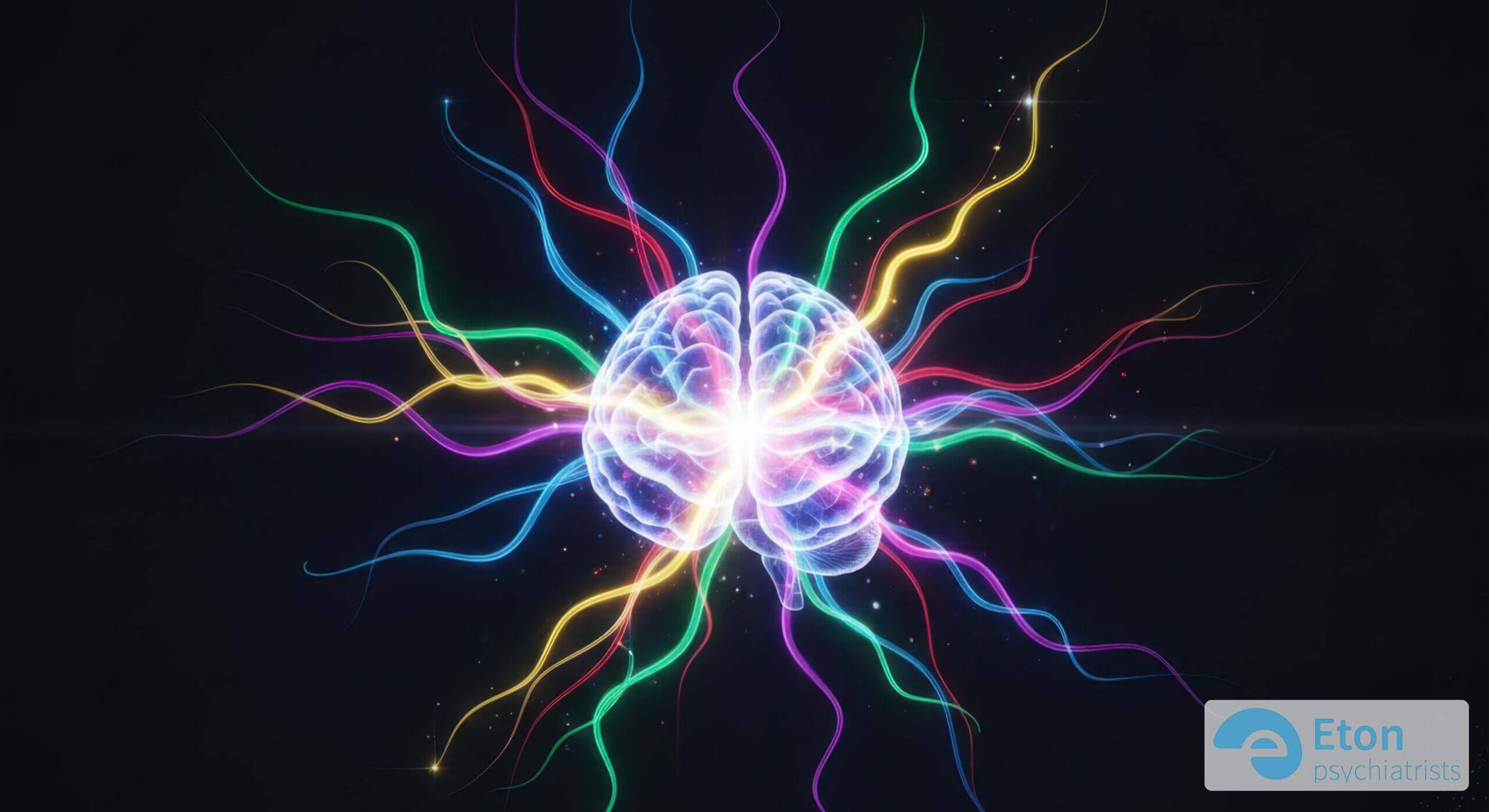
Autism in Women: Navigating Diagnostic Challenges and Support Needs
Listen to the Article
For those on the go or who prefer listening, you can play the full audio version of this deep dive below.

For many women, the path to an autism diagnosis is long and complex, often arriving much later in life. Countless women navigate adulthood feeling perpetually overwhelmed, managing careers, families, and social lives while battling unseen challenges with social communication, sensory processing, and intense interests. They might be labelled as “shy,” “anxious,” “too intense,” or “quirky.” The truth may be undiagnosed autism in women, a presentation frequently missed due to outdated stereotypes focusing on male traits, the nuances of female autistic masking, and diagnostic criteria historically biased towards childhood presentations.
This systemic oversight has profound impacts, often leading to mental health struggles like anxiety, depression, and burnout. This guide explores the unique characteristics of autism symptoms in women, the reasons behind diagnostic delays, the challenges of masking, and the importance of accessing informed support. Our goal is to validate these experiences and provide the clarity needed to understand the female autistic profile.
Table of Contents
- Diagnostic Bias: Why Autism in Girls is Missed
- Common Female Autism Traits
- Female Autistic Masking: The Performance of Normality
- Autistic Burnout and Mental Health in Women
- Alexithymia: The Challenge of Identifying Emotions
- Autistic Women in Relationships
- Autism in Mothers: Navigating Parenthood
- The Path to Diagnosis for Women
- Why Trust Eton Psychiatrists?
- Summary
- Sources
- Frequently Asked Questions
Diagnostic Bias: Why Autism in Girls is Missed
The underdiagnosis of autism in women often begins in childhood. Traditional diagnostic criteria and societal understanding of autism were largely developed based on observing autistic boys. Boys are more likely to exhibit externalising behaviours such as obvious repetitive movements, disruptive conduct, or overt challenges with social rules. This created a male centric prototype of autism.
Autism in girls, however, often presents more internally. Girls may have intense interests considered more socially acceptable (like literature or animals), develop strong imaginative play, or exhibit quieter repetitive behaviours (like skin picking or hair twirling). Their social challenges might manifest as being overly passive, mimicking peers effectively, or having one or two intense friendships rather than broader group difficulties. Because they are less likely to disrupt the classroom, their struggles are often misinterpreted as shyness, anxiety, or simply personality quirks, allowing them to fly under the diagnostic radar for years, even decades.
Common Female Autism Traits
While autism varies greatly between individuals, certain traits are frequently observed in autistic women, often differing in presentation from autistic men:
- Intense Interests (“Special Interests”): While common across genders, the focus of these interests in women may be more socially oriented (e.g., psychology, specific fictional characters, social justice).
- Strong Empathy (often Cognitive/Intellectual): Contrary to stereotypes, many autistic women experience intense empathy, sometimes feeling overwhelmed by others’ emotions. This may coexist with challenges in intuitively understanding social cues (affective empathy).
- Sensory Sensitivities: Heightened sensitivity to light, sound, touch, or smell is common, often leading to overwhelm in busy environments.
- Need for Routine and Predictability: A preference for structure and difficulty with unexpected changes.
- Social Communication Differences: Challenges may be less about lacking social interest and more about difficulties with small talk, navigating unspoken social rules, processing conversations in real time, or experiencing social exhaustion after interactions.
- Executive Function Challenges: Difficulties with planning, organisation, initiating tasks, and managing time, similar to ADHD (which often co-occurs).
- Logical or Analytical Thinking: A tendency towards systematic thinking and pattern recognition.
Female Autistic Masking: The Performance of Normality
Female autistic masking, also known as camouflaging, is a significant reason why autism remains hidden in women. Driven by a desire to fit in and avoid negative social consequences, women learn to consciously or unconsciously suppress their natural autistic traits and perform neurotypical behaviours.

This performance can involve forcing eye contact despite discomfort, mimicking the body language and expressions of others, scripting conversations in advance, suppressing stimming behaviours, and pushing through sensory overwhelm. While effective for navigating social situations, masking is incredibly mentally taxing. It requires constant self monitoring and cognitive effort, akin to running complex social software in the background at all times. This sustained effort is a major contributor to autistic burnout women experience and can significantly impact mental health.
Autistic Burnout and Mental Health in Women
The cumulative effect of navigating a world not designed for autistic neurology, combined with the exhaustion of masking, often leads to autistic burnout. This is not simply tiredness; it’s a state of profound physical, mental, and emotional exhaustion, often accompanied by increased autistic traits and a loss of skills. Autistic burnout women describe can manifest as extreme withdrawal, increased sensory sensitivity, loss of executive function, and shutdowns or meltdowns.

Undiagnosed autism in women is strongly linked to co-occurring mental health conditions. The constant struggle to meet neurotypical expectations, experiences of social rejection or misunderstanding, and the internalised feeling of being “wrong” or “broken” contribute to high rates of anxiety disorders, depression, and C-PTSD. Often, women seek help for these mental health issues without realising that undiagnosed autism is the underlying factor driving their distress.
Alexithymia: The Challenge of Identifying Emotions
Alexithymia, a difficulty identifying and describing one’s own emotions, is commonly associated with autism, though it’s a separate condition. Alexithymia in women can further complicate the autistic experience. It can make it challenging to understand internal states, communicate emotional needs effectively in relationships, or recognise the early signs of burnout or mental health difficulties. This doesn’t mean autistic women don’t feel emotions deeply; rather, they may struggle to put those feelings into words or connect them to specific triggers.
Autistic Women in Relationships
Autistic women relationships can be deeply rewarding but may also present unique dynamics. Communication differences can lead to misunderstandings if partners expect neurotypical social cues or interpretations. Sensory sensitivities might impact intimacy or shared activities. Honesty, direct communication, mutual understanding of needs (e.g., for downtime after socialising), and appreciating different ways of showing affection are key to navigating relationships successfully.
Autism in Mothers: Navigating Parenthood
Autism in mothers brings both unique strengths and challenges. Strengths might include intense focus on a child’s needs, honesty in communication, and creating structured, predictable home environments. Challenges often involve sensory overload from the constant demands of childcare, difficulties with multitasking and executive function required for managing a household, and social pressures related to parenting groups or school interactions. Autistic mothers often benefit significantly from practical support, clear communication from partners, and strategies to manage sensory input and prevent burnout.
The Path to Diagnosis for Women
Receiving an autism diagnosis as an adult woman is often a profoundly validating experience. It provides a framework for understanding past struggles, reframes perceived personal failings as neurological differences, and unlocks access to appropriate support and self acceptance.

The diagnostic process should involve clinicians experienced in the female presentation of autism. This includes recognising subtle signs, understanding masking, and using assessment tools appropriately. A comprehensive assessment typically involves detailed clinical interviews about developmental history and current functioning (like the ADI-R), observational assessments (like the ADOS-2), and potentially input from family members. Finding a clinician who practices from a neurodiversity affirming perspective is crucial for a positive diagnostic experience.
Why Trust Eton Psychiatrists?
At Eton Psychiatrists, we specialise in ADHD and Autism assessments for adults, with extensive experience in recognising the nuanced presentation of autism in women. Our multidisciplinary team uses NICE guideline compliant methods, including gold standard tools like the ADOS-2 and ADI-R, delivered within a neurodiversity affirming framework. We understand the significance of masking and late diagnosis, providing a safe, validating space for women to explore their experiences and receive the clarity they deserve.
Summary
- Hidden Presentation: Autism in women is often missed due to diagnostic bias towards male traits, quieter internal symptoms (common in girls), and societal pressures leading to masking.
- Female Traits: Common traits include intense interests (sometimes socially focused), strong empathy, sensory sensitivities, social communication differences (often masked), and executive function challenges.
- Masking’s Toll: Female autistic masking involves consciously suppressing autistic traits to fit in, requiring immense effort that leads to burnout, anxiety, and depression.
- Mental Health Link: Undiagnosed autism is strongly linked to co-occurring anxiety, depression, and autistic burnout, often due to the stress of masking and navigating an unaccommodating world.
- Validation Through Diagnosis: A late diagnosis can be profoundly validating, providing explanations for lifelong experiences. Seeking clinicians experienced in female autism is crucial for an accurate assessment.
Sources
Frequently Asked Questions
What are the main signs of autism in women?
Signs can be subtle and include intense interests, high empathy (sometimes alongside social cue difficulties), sensory sensitivities, preference for routine, challenges with executive function, logical thinking, and significant mental effort involved in socialising (masking). Internal experiences like anxiety and exhaustion are also common.
Can you develop autism later in life as a woman?
Autism is a neurodevelopmental condition, meaning it’s present from birth, though signs may not be recognised until later. Women often receive a diagnosis in adulthood because their traits were missed in childhood due to masking or presenting differently than the male stereotype. It’s a late diagnosis, not late onset.
What does autistic masking look like in females?
It involves actively suppressing natural autistic behaviours. Examples include forcing eye contact, mimicking neurotypical social behaviours (gestures, phrases), scripting conversations, hiding stims (like fidgeting), and pushing through sensory discomfort in social situations.
How does autism affect women in relationships?
It varies greatly. Challenges can arise from differences in communication styles, sensory needs impacting intimacy, or social energy limits. Strengths often include loyalty, honesty, deep connection over shared interests, and unique perspectives. Open communication and mutual understanding are key.



